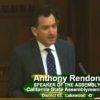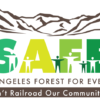Crowds descended upon the High-Speed Rail Authority board meeting held in Los Angeles on June 9th. Literally 100’s of people arrived on buses. Many took off from work to make public comment about the Palmdale to Burbank segment and the four possible design routes being studied. The board meeting lasted 8 hours with public comment lasting nearly 3/4ths of the time. Not everyone had seats and according to one of the speakers there were a couple hundred people unable to come into the main meeting room. They were relegated to a room with substandard audio and video.
Prior to the board meeting there was a rally well attended by project opponents who are displeased with the Authority’s routing alternatives. See ABC’s video of the rally: http://abc7.com/travel/high-speed-rail-brings-fears-of-gutted-communities-noise/775209/
While the main event was no doubt the public outcry concerning the routes, there were other important subjects up for discussion and decisions. The long awaited award of the program management contract was the last item presented in front of a nearly empty room. Parsons Brinckerhoff (PB) was re-awarded a contract valued at $700 million over a 7 year period, $30 million of it in the form of a performance based on benchmarks yet to be established It appears that Bechtel, the other company who submitted a bid, was a very close second.
CEO Jeff Morales, a former high-level executive at PB, said that the contract was on par with what the Authority would spend if it added staff but it might be less using consultants because there wouldn’t be long-term obligations to the state employees if they were on staff. Item5 Resolution HSRA15 11 Consider Providing Approval to Execute and Award the Rail
There were many concerned about the destruction of the peaceful rural life near the city of Los Angeles. They voiced concern not only for the people but also for the animals who would be displaced with nowhere to go. Several stated endangered species were in the segment and would be threatened by the project. There were concerns about disruption of underground aquifers, which cannot be mitigated if a tunnel design was selected under the Angeles National Forest. Numerous residents highlighted water as the chief need of the state. One speaker told the board about the issues with Valley Fever and asthma which would no doubt rise because of the construction dust. It would affect the communities for decades and harm both people and animals.
A common issue voiced over and over again was that the Authority would not listen to their concerns. They objected to how the Authority ran public outreach meetings. The Authority representatives would not answer questions the public had. Even this meeting was a one-way conversation, but this time it was the residents telling the Authority what their concerns were however the Authority did not offer answers. This is typical at public outreach meetings as well as typical at board meetings. The explanation given by the Authority was that they did not want to inhibit others from speaking and it was the public’s time to comment.
Some felt the project management was guilty of social injustice against minority and disadvantaged communities. It was echoed several speakers. It seems history shows the disadvantaged are targeted when it comes to public development. Some of the poorer communities stated they had been invaded by highway construction three times in the past.
The residents also seem to be stuck where they live now because of the Rail Authority’s lengthy processes. Since the final route selection process might take up to two years, it’s very hard to sell a home or get a construction loan. A real estate spokesperson reminded the Authority they were obligated to disclose that the homes were in the path of the train and that values were dropping. Later the Authority board voted to commission a study done by an independent source such as an expert from the University system that would examine the different routes. Their assignment would be to look for major issues or as Chairman Richard suggested, showstoppers.
Jeff Morales, CEO reminded the board that these studies would not be sufficient to make an alignment decision but would look at viability. However this could accelerate a board decision to narrow down alternatives earlier if the report showed issues that made a route totally infeasible.
Cities such as Acton, Shadow Hills, San Fernando, Santa Clarita, Agua Dulce, Pacoima, Sylmar and several foothills communities were strongly represented.
Anaheim council member Chris Murray said the Authority’s staff always worked with them in a cooperative and collegial manner and answered their concerns, which made a real difference. This is unlike remarks from other cities that had issues getting answers. Palmdale spoke in favor of the project since their city will be the recipient of badly needed transit and jobs. It seemed from the various comments that if you were a project advocate, you received better service.
Acton, a rural community noted for their horse community advocated the tunnel option under the Angeles National Forest. Acton will be affected no matter what route is chosen. Acton was told a tunnel was infeasible. One resident, Jacki Ayer, who holds a masters degree in engineering explained to Rail Authority staff just how it could be done.
Tippi Hedren, made famous by her role in Alfred Hitchcock’s, “The Birds, “ now dedicates her life caring for big cats and has established a preserve for them. She stated she was more afraid of the High-Speed Rail Authority board. She told them they do not listen to the concerns of the residents. Her comments: http://youtu.be/NnJw_VUH2Vo
San Fernando may be a small city but they are strongly represented by their council. Mayor Joel Fajardo made an impassioned plea. He told the board that San Fernando has been fighting the SR-14 route for two years and that if implemented could bankrupt their city. Fajardo said this route adversely affects their working class community. He declares the Rail Authority would not consider these routes for wealthier communities. See this you-tube with a sample of comments including Mayor Fajardo, first up on the video. https://www.youtube.com/watch?v=sJ7mXJbeaEc Note: The Authority’s video will be up in a week or two and you can see all commentary and the actual board agenda that was conducted.
Council Member Jaime Soto, a history teacher in the community college District of LA County said this is an example of no dialogue between HSR and the community. The Rail Authority personnel refuse to answer questions. “We will not stand for SR-14 to go through our city and destroy it,” Soto said, “ I tell my students that they have the right to Life, Liberty and the Pursuit of Happiness.” Listen to the people. Do not sacrifice San Fernando for some benefit for the future that could be directed someplace else.
Mayor Pro Tem, Sylvia Ballin was one of the organizers of the rally prior to the meeting. She explained that the rail authority would not allow questions at Open House on May 18th. San Fernando’s City Manager asked the Authority to allow questions and the rail authority personnel said said they would not change their format, no questions would be allowed. Ballin explained the many attempts the council made trying to work with the staff but to no avail.
She does not want the high-speed rail to pass through San Fernando neither above ground or underground HSR service.
Here is her Op Ed published recently which expresses the city’s frustrations. http://www.sanfernandosun.com/news/article_6b66e8c2-0546-11e5-bf81-3b4fe94a3b77.html#.VXHkWA5K33Y.mailto
Concerns outlined by San Fernando leaders and residents included division of the city by a 20-foot wall, loss of city revenue caused by the dislocation of businesses, jobs and homes irreplaceable because of memories of generations who had been there before. Removal of the alternative of SR-14 was the battle cry for San Fernando.
Santa Clarita also wanted to make it clear that they advocate a fully underground route, no surface alignments. They too wanted the elimination of SR-14. The Mayor, Marsha McLean told the board that since the inception of the project Santa Clarita attempted to work with the HSR staff to eliminate negative impacts of the proposed project for Santa Clarita residents. She put together a coalition to ensure a cohesive body along the SR-14 corridor in order to insure that neighborhoods in the Palmdale to Burbank were not negatively impacted by HSR. She reminded the board that 1500 people went to their community meeting on April 27th and then McLean presented the board with 1097 signatures collected in person and on line. She warned the board that they have a choice either 300,000 people opposing the surface alignment or advance only underground routing going from Burbank Airport to Palmdale.
Shadow Hills, an equestrian community with nature trails, horse boarding facilities and recreation areas. This said their community was one of the last places offering this rural lifestyle so close to Los Angeles. The community did not want the alignments that go under the Angeles National Forest, which could possibly disturb aquifers, which supply approximately 15% of the drinking water of Los Angeles. It was explained by one speaker that tunneling does destruction to the Forest even during the environmental process since with soil testing they had to drill deep into the soil. In addition if the underground route is chosen, they need at least three above ground portals requiring 15 acres of land each and an 18-foot wide road necessary for emergency equipment.
Dave DePinto, President of Shadow Hills Property Owners Association and spokesman of SAFE, (Save Angeles Forest for Everyone) http://www.dontrailroad.us told the board that he feels the Burbank alternative should be reexamined considering it’s a Superfund site and the damage it does to the communities and the environment. There are other clear alternatives than this route. DePinto couldn’t get a straight answer by the Rail Authority if the Burbank station was a requirement of the bond measure.
At one point there were people who made public comments about this situation, which caused cities to be pitted against cities. Several people said they expected I-5 would be the route when they voted for the Proposition back in 2008. (That alternative was abandoned in 1996 without sufficient explanation as to why) Many mentioned this wasn’t the project they voted for. One woman commented that Prop 1A back then was “high on polish and low on content.” Another resident, Shannon McGuiness from Kagel Canyon confessed that she originally voted for high-speed rail but “if I had a second change I would vote for water not rail.”
There were speakers who addressed the more holistic approach questioning the wisdom of the project. They listed the lack of financing for the overall project, the travel times promised. They expressed the need to put this on the ballot again since this wasn’t what they voted for. Several people mentioned the need for Governor Brown to reprioritize his agenda and move away from the train project to take care of the water crisis, which affected everyone.
Sam Edgeman from Shadow Hills debated with his friends who said it was too late, the vote occurred, they’re spending money, it’s going to happen. Edgeman insisted, “It doesn’t have to happen. It’s not too late to stop it. There are no tracks, no trains.” He mentioned that though money had been spent, huge amounts of money are remaining to be spent. He suggested pay the contractors contracts since they are the only ones benefiting. There’s nothing in this for the local people he stated. In addition he warned the audience and the board, it is nearly impossible to build a tunnel from Palmdale to Burbank. “The train shouldn’t go under-ground instead it should go into a grave and go away. “
Alan Scott from Kings County’s Citizens for California for High-Speed Rail Accountability (CCHSRA) told the board this meeting was a case of déjà vu for him. Some 300 Central Valley residents protested their alignment in the summer of 2011. http://www.examiner.com/article/sacramento-legislators-hear-the-central-valley-loud-and-clear
Scott told the board that
now four years later, we’re hearing the same things. He suggested that the Authority be dissolved as Joe Vranich, former Chairman of the High-Speed Rail Association, at a State Senate Transportation meeting suggested on October 23, 2008. This was just before the initiative was presented to the public for a vote. https://www.youtube.com/watch?v=SS0RD6dqpKY
Note: The San Jose to San Francisco segment also had extensive commentary before the Senate passed the first appropriation bill back in 2012. See Mountain View Meeting where 450 people attended and most spoke. http://www.examiner.com/article/mountain-view-high-speed-rail-meeting-gives-clues-to-the-future-of-the-project And that was just one meeting that large numbers of Bay Area residents protested.
Frank Oliveira, CCHSRA co-founder, came to tell the board that not much has changed, the similarities of the complaints with these residents are the same as those of Kings County and Fresno Counties. Despite what people at the meeting said today about the Authority not hearing them, Oliveira said he believed that the Authority Board did listen but they do not consider what the people are saying. He told the people in the room what they don’t understand is that the Authority makes the plan, they review the plan and they approve the plan. And if there is a problem, they have the final word and can rule that certain risk is acceptable loss. Oliveira said eventually the people in the room will be where Kings County and Fresno County are today about compensation for their properties. He explained that the Authority was actively acquiring properties for inventory. He was offered 25% of what he believed his property was worth. He advised them to consult with the Federal Railroad Administration (FRA) since the Authority was not required to follow CEQA by a decision of the Surface Transportation Board. He advised them to hold the politicians accountable for the decisions they’ve made to get us to this point.




